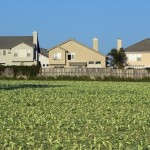
Over the last 25 years, concerned citizens in the San Joaquin Valley have tried to change growth policies in order to build sustainable communities. Citizens from interest groups such as Sierra Club, Audubon, GOAL: Growth, Orderly Affordable, and Livable, and FOOD: Future Options On Development, have had minimal impact on the rate of urban growth policies, the manner in which land is used, or conservation of the environment.
Political groups in control of communities tend to oppose the agendas of the citizen groups. The controllers argue that growth and opportunity have been hindered by the efforts of the concerned citizens. However, a critical examination of land use and resource patterns indicates that citizen interest groups have had minimal effect on growth policies or the long term sustainability of Valley economies. In fact, the narrow minded focus of development groups on residential rather than industrial development has led to unemployment rates double the state of California average and stagnant economies. Given growth patterns of the last 25 years, not enough resources exist to continue the development policies of the past.
The Basic Problems
Each acre of land added for urban development shortchanges the sustainability of future populations. Inadequate water for farming and urban use means that rivers and streams cannot be kept full of water for a healthy ecosystem. High levels of air pollution continue to aggravate the health of citizens via asthma and shortened life expectancy. Food production is not increasing as fast as population increases add to demand.
The long term trends are leading towards larger unsolved problems while the wrong solutions are promoted by those who control the population’s destiny. Citizen groups like the Sierra Club have had to shift to no growth strategies because the politicians are unwilling to do what is needed to build a sustainable society.
Solutions Proposed vs. Solutions Needed
Here are a few examples of what is needed to be done and what has actually been proposed. Water sources need to be enhanced. Coastal communities need to desalinate water so that inland communities can keep their water. Instead, the Governor proposes a big tunnel project that will move water but will not add to the total supply. Bigger dams are proposed that will create larger storage, but further degrade rivers and disrupt the valley ecosystem.
Air pollution needs to be reduced. Instead of creating local jobs, more houses and freeways are built, encouraging more air pollution from larger numbers of commuters driving longer distances. Instead of raising gasoline taxes to encourage the use of more fuel efficient cars and car pools, ineffective advertising has little effect on conservation of resources.
Land use patterns have not changed much. In the last 25 years, communities have made little progress in protecting farm land for food production, increasing urban land use density, or engaging in smart growth strategies. Urban blight continues to expand within the cities while farm land is chewed up for new urban growth.
Urban limit lines would force cities to make better use of the land within their borders. Growth would become denser as cities would grow upward instead of outward. Agricultural land would be protected, making the future more sustainable.
Still Building an Unsustainable Economy
The present model used for economic growth is not sustainable. The question is, when will it end? How bad does the Valley have to become before those in a position to do something fix it? When will voters stop supporting candidates dedicated to more housing and fewer farms?
